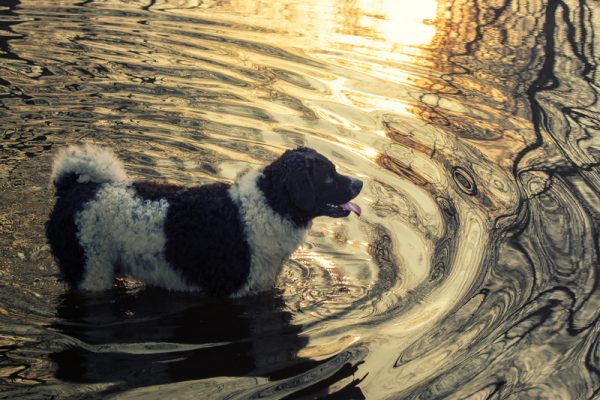
An internet search for “Otterhoun” inevitably brings up thousands of “hits” for the fabulous Otterhound, but unless one adds “frisian water dog” to the search, one might be left thinking that’s all there is.
Au contraire!
The Frisian Water Dog, better known as the Wetterhoun, is also known as the Otterhûn, a moniker that reflects the breed’s original function as an otter hunter. Digging into the breed’s use in this capacity means running into different theories about its origins, and one of them points to the Wetterhoun’s ancestors as having arrived in Friesland on flat-bottomed eel boats. Eel trading was a robust activity from the 1600s well into the 1900s, and eel fishermen would have been keen to eliminate competition for their catch. Otters eat eels (as well as fish) and thus were a headache for fishermen and eel-men.
And oh, back in the day? People ate otters.
Indeed, a 16th century cookbook mentioned that otters could be eaten on Fridays when only fish was permitted, and since otters lived in water like fish, it was allowed. Otter was an ingredient used in delicate dishes such as smoked eel, and was a staple in the Netherlands. Even now, smoked eel known as gerookte paling is a Dutch delicacy.
Beyond the kitchen, there was demand for otters because their hide could fetch as much as 25 guilders. For context, we checked with lensonleeuwenhoek.net and learned that back in the year 1660, 314 guilders were equivalent to a year and a half’s worth of wages for an unskilled worker, or roughly $29,927 in US dollars today. Over three hundred years ago, even a small fraction of that that would have fetched someone a lot of money. Needless to say, a dog that could hunt an animal of value while eliminating that same animal as competition for a food source was a handy dog to have around! These early water dogs had excellent noses, and as Janny Offereins and Diana Striegel write in their excellent book, Amazing Dutch Dog Breeds, once an otter was located, the dog would give a “high pitched icy bay” making short work of locating one. Nor would the dog hesitate to plunge into frigid water to do battle with a otter, its oily, astrakhan-like coat protecting it (a skilled swimmer, the Wetterhoun’s name translates to ‘Water Dog’ in Dutch).
In 1942, the Dutch government protected the otter as a species, and hunting them was permitted only with a special permit. Eleven years later, it was banned altogether.
It must have felt too late. The last time an otter was spotted in Amsterdam was in 1963, and then seems to have completely disappeared from the Netherlands by 1988, this according to urban ecologist, Geert Timmermans. It was very exciting, then, when an otter was spotted in Amsterdam last year in 2022. You don’t need to understand Dutch to feel the enthusiasm of the spotters in the video below:
It wasn’t the Wetterhoun that was ultimately to blame for the otter’s struggle. Water pollution, and especially car traffic, was the biggest threat to these creatures. In fact, when the otter was spotted last year, its exact location was kept a secret so he (or she) wouldn’t be bothered with looky-loos. It’s hoped that improved water quality and under-road passages to help this member of the Lutrinae subfamily cross safely will attract more otters.
And what about the Wetterhoun? Did this quiet (and some say stubborn) dog find itself out of a job?
Hardly. In addition to being a fine family companion, hunting dog and guard dog, the Wetterhoun has been helping the Dutch with an overabundance of geese.
